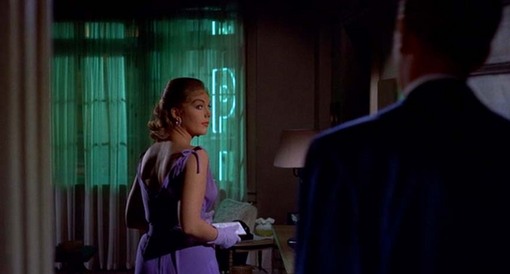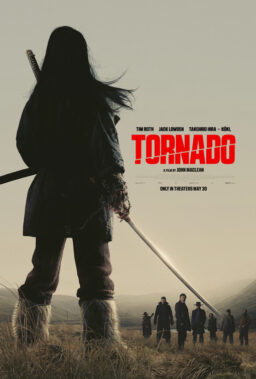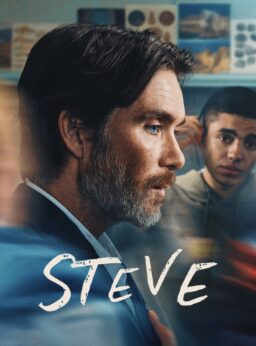This appreciation is a slightly revised-for-2012 version of an article originally published online at Microsoft Cinemania in 1996. It was just one of several pieces in a package celebrating the 70mm restoration release of “Vertigo” that year.
Alfred Hitchcock’s “Vertigo” is one of the most ravishing Technicolor films ever made — all the more so in its VistaVision-to-70mm restored version. And color plays a key part in the mystery, emotion and psychology, of the film. Colors evoke feelings, and while Hitchcock liked to say that “Psycho” (made two years later) was “pure cinema” in black-and-white, “Vertigo” is a symphony of color, its multi-hued themes and motifs as vividly orchestrated as Bernard Herrmann’s famous score.

I first saw “Vertigo” on network television in the late 1960s or early 70s, shortly before it was withdrawn from release. I think I was somewhere between 12 and 14 years old — I know I saw it by myself on my parents’ new 19-inch color TV one night when mom and dad went to some neighborhood grown-up party — and I’m sure I didn’t understand the half of it. But it stayed with me — haunted me, you might say — between that fateful evening and its re-release in the mid-80s. By then, “Vertigo” had become, if not quite the Holy Grail of the American Cinema (after all, “Rear Window” and “The Manchurian Candidate” had been unavailable for years, too — and a great deal of “The Magnificent Ambersons” is still at the bottom of the ocean), then at least one of its most coveted (and fetishized) treasures.
In 1982, shortly before its re-release, the 100 international critics participating in Sight & Sound‘s decennial poll named Vertigo one of the 10 greatest films of all time (it was sandwiched between “The Magnificent Ambersons” and the 10th-place tie of “The General” and “The Searchers“). By 1992, its reputation had floated it up to No. 4 (after “Citizen Kane,” “Rules of the Game,” and Tokyo Story”). The 1992 poll of leading international directors placed “Vertigo” in a three-way tie for No. 6, along with “The Godfather” and “Modern Times.” Ten years later, it squeaked in just behind the perennial favorite “Citizen Kane,” in 2012 it supplanted “Kane” at the top of the poll.

I knew “Vertigo” was a great movie the first time I saw it. It mesmerized and haunted me, even though I was too young to fully understand why. To put it in some sort of perspective: to call the 70mm restoration/re-release “the best movie of 1996” would be not only trite, but a laughable understatement; quite simply, few filmmakers have ever orchestrated colors, compositions, music, gestures, language with quite this richness and intensity.


But the thing I remember most about “Vertigo,” the thing that imprinted itself indelibly on my brain, was something simple and powerful: the color green. Say “Vertigo” and I see green. For the color green is associated with the object of Scottie Ferguson’s obsession, Madeleine (think Proust), his vertigo and, especially, its underlying cause: the dizzying fear of falling, and of falling precipitously, deliriously in love.
Scottie (James Stewart) is a middle-aged man (Stewart was 49 when the movie was shot) who lives alone (“Some people prefer it…”) and has never married, a former police detective who has retired after the terrifying discovery that he suffers from vertigo — a fear of heights that indirectly leads to the death of a fellow policeman.

(This nightmarish, deep-indigo episode forms the movie’s prologue, and Scottie is literally left hanging; as critic Robin Wood has noted: “We do not see, and are never told, how he got down; there seems to be no way he could have got down. The effect is of leaving him, throughout the film, metaphorically suspended over a great abyss.”)

Although Scottie and his friend Midge (Barbara Bel Geddes) have an easygoing rapport, there’s something passive, distant, disconnected, about Scottie. Midge is obviously head-over-heels for him — a love that expresses itself more maternally than romantically — but either he doesn’t realize it or doesn’t choose to reciprocate beyond friendship. While Midge flirtingly discusses the architecture of the brassiere (her banter is bright but all on the surface, despite her deep feelings; she’s “a known quantity,” in Wood’s words), Madeleine (Kim Novak) is introduced as a mystery woman.


At Ernie’s restaurant, a blood-red San Francisco institution (womb-like — a place in which a bloody romantic obsession is born), Madeleine appears, walking through a doorway in a deep-green stole and pauses in profile like a mysterious sculpture that Hitchcock scholar François Truffaut reprised four years later, immortalizing the beauty of Jeanne Moreau’s Catherine in his film “Jules and Jim.” (It is interesting to note that Madeleine often appears through a doorway — indicating that there’s something behind her, in her past, that is only partially visible to us, and to Scottie.) She exits the scene in mirror images — because, of course, there’s not just one “Madeleine,” but two.


In this manner Madeleine, and the color green, are introduced into “Vertigo,” and Scottie’s subconscious. (The preceding three scenes — the vertiginous prologue, the scene at Midge’s loft, and the scene in Elster’s office, are virtually without green, with the exception of a potted plant that appears behind and between Scottie and Elster when the latter solicits Scottie’s help in spying on his wife. That splash of green is a small portent of Scottie’s soon-to-blossom romantic obsession with Madeleine…)
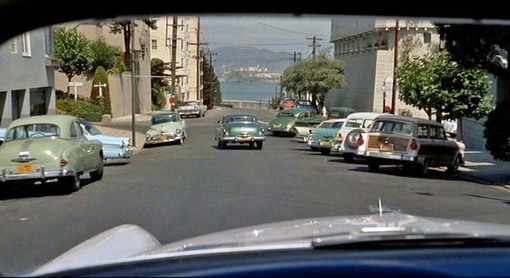

And so, green is associated with Madeleine, and with the romantic environs of San Francisco. Madeleine’s car, which Scottie so obsessively tails, is green (and there’s a splendid moment of disconcerting, schizophrenic foreshadowing when Scottie spies two identical green cars rounding a curve; we’ll later be left wondering just how/where/if the paths of Madeleine and her look-alike Judy have diverged). It’s in this scene that Scottie, frustrated by Madeleine’s seemingly aimless wandering, eventually realizes she’s led him back to himself — to his own red front door.




And there’s the green expanse of lawn in front of the Palace of the Legion of Honor art gallery, where she goes to sit in front of the portrait of Carlotta, the greenery of the florist’s shop and its vibrant green boxes (also associated, in Scottie’s thrillingly up-close surveillance of Madeleine, with her image in a mirror — as his whole world bursts into vibrant color), the garden graveyard where he follows her, and the deep green-blue waters of San Francisco Bay into which she throws herself.


Following her “suicide attempt,” Madeleine reprises her initial entrance in Scottie’s apartment, coming toward him (and the camera) in a red robe that reminds us of the decor of Ernie’s restaurant in which we first spied her. On a table to the right of the frame is a striking green box (an ice bucket?) reminiscent of those at Madeleine’s florist — so green that it’s somewhat distracting. The color scheme — red suggesting Scottie’s fear/caution/hesitancy when it comes to romance, and its opposite green, suggesting the Edenic bliss (and/or watery oblivion) of his infatuation with Madeleine (or, from Midge’s point of view, jealousy) — seems to be indicating perhaps that Madeleine may appear to be one thing, but may actually be another.

After taking the plunge for Madeleine, even Scottie switches from his usual blue/gray and wears a gray-green sweater. He’s undergoing something of a sea change. Later, after Madeleine abruptly and mysteriously disappears, Scottie opens the bright red door to his apartment and finds himself bathed in a greenish porch light, the afterglow of Madeleine’s presence.


Madeleine herself dresses most frequently in gray or black-and-white, a perfect neutral screen on which Scottie can project his desires. The scene in which Scottie and Madeleine really fall for each other takes place in deep, dark green of the Muir Redwoods (there’s that juxtaposition of opposite hues red and green again). These are indeed the Trees of Mystery (as bumper stickers proclaim them a ways up the coast), and they provide the atmosphere for “Vertigo”‘s most mysterious, haunting, and erotic scene in which Madeleine, seeming to recall a former life as Carlotta, ruminates on the insignificance of human beings in a timeless landscape.

“Their true name is Sequoia sempervirens — ‘always green, ever-living,'” says Scottie of these magnificent sentinels, but for Madeleine they are reminders of the transience of human life — and particularly of her impending death, which will also mean the inevitable death of the romantic illusion she now finds herself sharing with Scottie. The scene ends with Madeleine and Scottie embracing near the crashing surf of the rocky Northern California coast, a reminder of the waters of San Francisco Bay.
Before we delve further into the green motif, let’s talk some more about red, and about blue, yellow, and purple, which also figure prominently in “Vertigo”‘s palette. As we’ve seen earlier, red is the opposite of green — a cautionary color, suggesting Scottie’s reluctance to get involved with members of the opposite sex.


The red door of Scottie’s apartment is a huge warning, a STOP sign for women. He prefers to live alone. Midge is wearing bright red when she attempts to put a stop to Scottie’s romantic illusions about Madeleine, by painting a parody portrait of herself as Carlotta (complete with large tortoise-shell frames). And Carlotta’s ruby necklace becomes the red flag that finally shatters Scottie’s romantic illusions about Madeleine/Judy. (The dialog in the moments before this vertiginous epiphany is subtly brilliant: Judy asks him to help her fasten her necklace. “How do you work this?” he wonders. “Can’t you see?” she asks. And then, chillingly, in the mirror, he does see — for the first time.)
Blue is associated with Scottie’s guilt (and to a lesser, more indirect extent with Gavin Elster). Of course, there’s the blue of James Stewart’s piercing, pained eyes; this is a movie about seeing, about appearances — “Vertigo”‘s opening title sequence itself emerges from a woman’s eye.
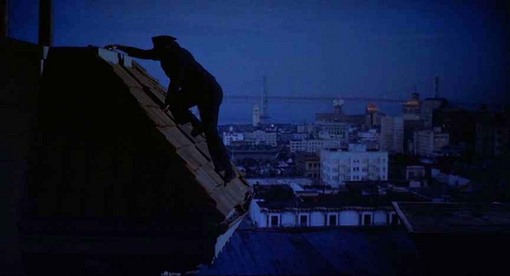
And the screen is drenched in blue in the prologue, the scene of Scottie’s guilt in the death of a fellow officer; in the azure day-for-night visit to the mission, the source of Scottie’s vertigo-related guilt over his inability to prevent Madeleine’s suicide leap; and on his return to the mission with Judy, where Scottie attempts to face the truth of what happened, and purge himself of guilt, and of his vertigo.

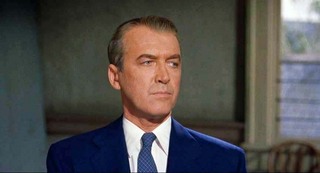
Scottie wears a blue suit and tie when he first visits Elster, who is dressed in gray-blue. And in the new print of “Vertigo,” the suits of Scottie and some of the other men in the tribunal who put the official, damning stamp on Scottie’s guilt, are so black-blue that they almost glow. The confirmation of his guilt leads to Scottie’s breakdown, after which he sits almost catatonically in his room in his guilty blue sweater. While initially tailing Madeleine, and again after first meeting Judy, Scottie dresses in brown, like a dying or dormant tree waiting to leaf out in green.


Midge is associated with soft, pastel shades — yellow, white, tan and cream colors — and traditionally feminine pink (the new bra, built on the principle of the cantilever bridge). Her studio, like her personality, is sunny, light, and airy — no mysterious shadows here. When Scottie attempts to show he’s mastered his vertigo, he climbs up on Midge’s yellow stool, and then collapses into her arms, which is right where she’d like to have him. The creaminess of her soft, pale yellow/cream sweater, and the emphasis on her breasts, both in the pink brassiere (fleshly and feminine) and the way she’s photographed, emphasize her womanly (and maternal) feelings for Scottie. Scottie often observes yellow-blonde Madeleine through hints of yellow (like the cannas in the graveyard) against a green background, as though looking past Midge, who’s right there in the foreground of his life, at the more distant obsession of Madeleine.



Judy is introduced wearing Madeleine’s green, while green florist vehicles are parked at the curb behind her. But when she tries to assert her own identity (i. e., not Madeleine), she chooses a purple outfit. A bold and distinctive (if somewhat garish) statement of her selfhood, it suits Judy’s brash personality perfectly — though all Scottie can see is that she clashes with the decor.



Near the climax of Scottie’s (and the movie’s) psychotic break/nightmare, his disembodied head floats amid flashing colors of green and purple; he hasn’t met Judy yet, the one who will remind him so strongly of Madeleine, but his dream prefigures his confusion between them: green, purple — and recurring flashes of red as if warning him of… something. It’s as though flash-forwards of Judy are already seeping into the film and Scottie’s consciousness, an endless purple abyss behind his face, which bathed alternately in Madeleine’s green and alarming red. When (in a radical departure from the structure of the source story) Hitchcock tips his hand and explains the mystery to us, but not to Scottie, two thirds of the way into the movie, it’s through Judy — who’s wearing the green associated with Madeleine.
In Scottie’s dream, Hitchcock splashes the screen with saturated colors that represent the conflicting psychological forces at war within Scottie, bombarding him (and us) with bursts of pure color and emotion: blue (guilt), red (caution, danger), green (Madeleine, romance, illusion), purple (Judy), yellow/pink (Midge) — the explosion of colors reminding us of the florist’s shop and the still-life flower arrangement in a painting to the left of Carlotta’s portrait.


Carlotta’s bouquet turns into a whirling Escher graphic that flashes green, a taunting and torturous reminder of Madeleine. And after his breakdown, the greenery outside his window seems to loom hauntingly behind him, like the ghost of Madeleine in the forest (“This is where I died…”), as unconsoling as Midge’s anti-depressant prescription dosage of Wolfgang Amadeus Mozart. A bouquet of roses — green growth tipped with garish bursts of blood red, the false promise of romance bursting at the ends with red flares of warning — seems to mock Scottie’s pain, but he sits in the corner, helpless.
Judy’s purple willpower doesn’t last long. After a couple of dates, she decides to let Scottie make her look “just a little” like Madeleine. Her vibrant purple outfit is replaced by a green skirt with a tan blouse, as Scottie searches for the exact gray suit Madeleine wore when she was killed. From Scottie’s point of view, Judy’s become kind of a half Madeleine and half Midge at this point. But what about Judy herself? Scottie basically refuses to acknowledge Judy’s right to exist.

Hitchcock told Truffaut that he had Judy live in the Hotel Empire because of its big, green neon sign. From inside Judy’s room, the whole room is suffused with that green light, filtered through fine-mesh curtains.
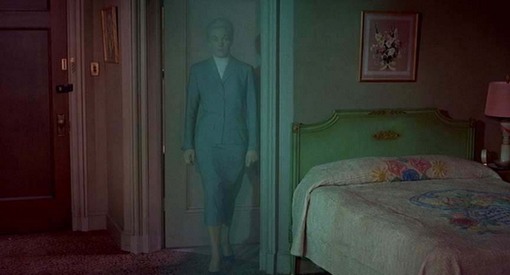

As Judy emerges from the bathroom, completing her visual transformation into Madeleine, she is bathed in green and shot through a hazy filter that recalls the soft, dreamy lighting of the garden sequence. Once again, Scottie has withdrawn himself from reality and into a romantic fantasy.

As he kisses Judy/Madeleine, the camera circles dizzyingly — vertiginously, you might say — around them and the whole world bursts into green — green, the color of rebirth, of growth. Everything seems to be complete for Scottie once again — except for a disturbing blue flashback to the mission. But Scottie shrugs it off and obsessively embraces his Madeleine — even though she’s really Judy. Green floods the frame once again. At this point, Scottie is more responsible for snuffing out Judy than he is for Madeleine’s death. Indeed, he’s smothered Judy to death with Madeleine.

Scottie can’t deal with reality — with a real flesh-and-blood woman. In the movie’s most heartbreaking scene, Judy senses that Scottie prefers an illusion: “You can’t even touch me!” And then, when Scottie begs her to change the color of her hair (color is such a vital part of Scottie’s obsessive fantasies; everything must be just so, from the suit to the coiffure), she asks: “If I let you change me, will that do it? If I do what you say… will you love me?” Like the artist in Edgar Allan Poe’s “The Oval Portrait,” Scottie is so obsessed with creating his “work of art,” that he doesn’t even notice that he’s draining the very life from his subject:
And in sooth some who beheld the portrait spoke of its resemblance in low words, as of a mighty marvel, and a proof not less of the power of the painter than of his deep love for her whom he depicted so surpassingly well… And when many weeks had passed, and but little remained to do, save one brush upon the mouth and one tint upon the eye, the spirit of the lady again flickered up as the flame within the socket of the lamp. And then the brush was given, and then the tint was placed; and, for one moment, the painter stood entranced before the work which he had wrought; but in the next, while he yet gazed, he grew tremulous and very pallid, and aghast, and crying with a loud voice, “This is indeed Life itself!” turned suddenly to regard his beloved: — She was dead! (Edgar Allan Poe, “The Oval Portrait”)
In the end, Scottie is “cured” of his obsessive fantasies, his romantic illusions — and, simultaneously, of his vertigo. But it’s a cure that leaves him on a precipice, staring directly into the great abyss…

– – – –
“Verdant Vertigo: Seeing Green in Technicolor” was first published on the web site of Microsoft Cinemania, edited by Jim Emerson, in ©1996.

